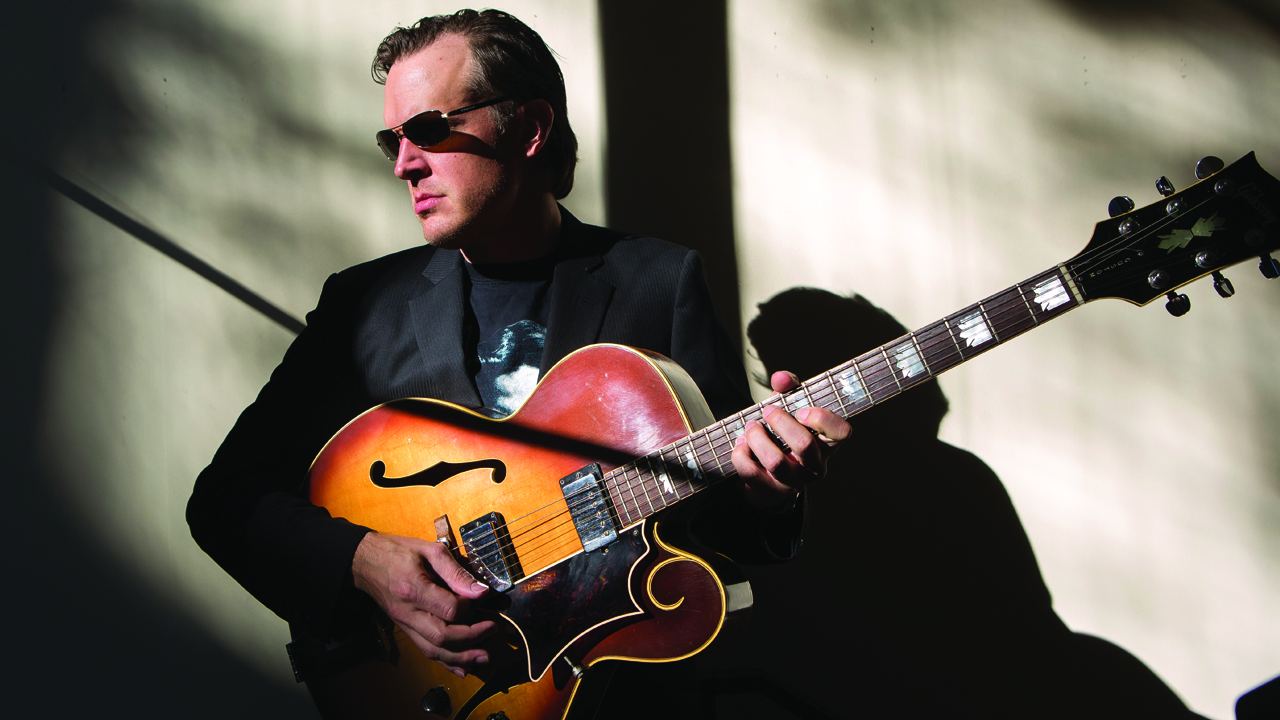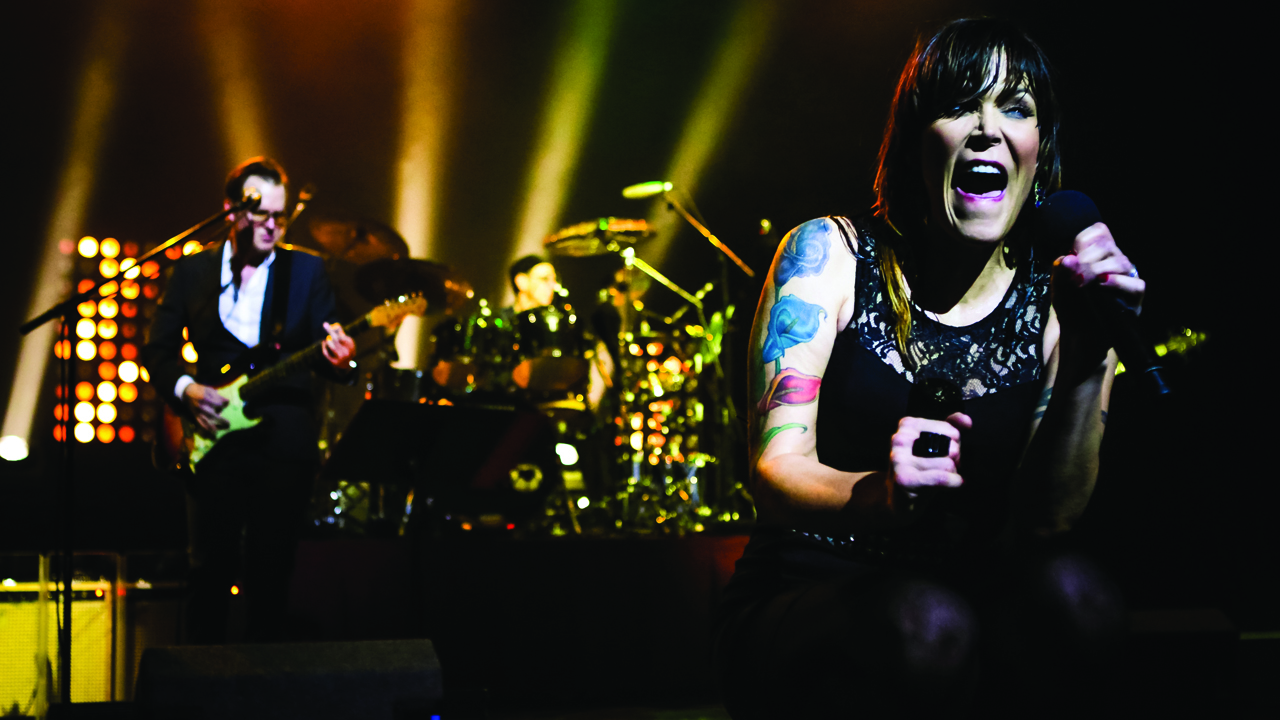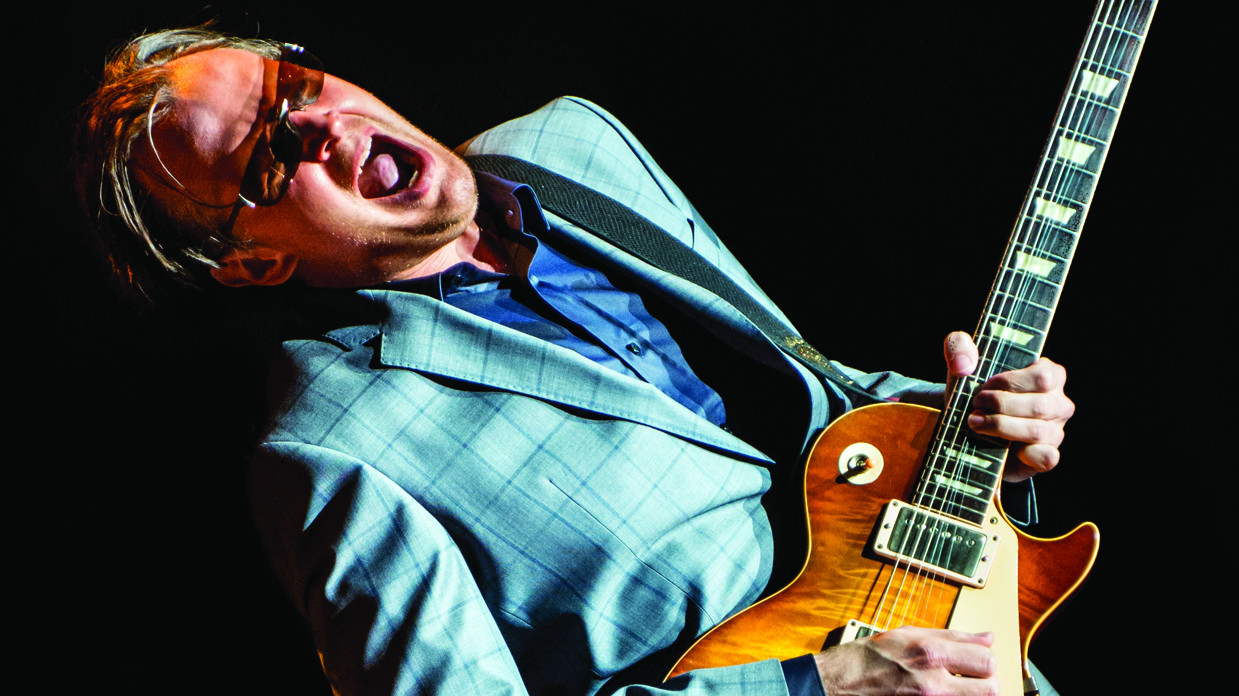The hardest-working man in show business. For years that phrase fit the Godfather of Soul, James Brown, like a velvet glove before it was applied (and self-applied) to dozens of other performers. These days, that title can rightfully be used to describe Joe Bonamassa, the modern blues titan, a tireless recording and touring monster, to whom the very idea of a holiday seems like anathema. Consider the facts: in the past 16 years, Bonamassa has released an astonishing 11 solo albums – no, we can make that 12 counting his just-issued new record Blues Of Desperation – 15 live recordings and DVDs, collaborated on a couple of albums with singer Beth Hart and his funk-jam side band, Rock Candy Funk Party, and he’s still managed to find the time to squeeze in more than 100 concert dates around the globe.
So how does Bonamassa bide his time before releasing what might be the record of his career? By temporarily benching his steady touring electric band and taking up with an eclectic band of world-class musicians (among them his regular touring and recording drummer, former Late Show With David Letterman player Anton Fig) for a month-long acoustic tour that crescendoed with a “bucket list” set of sold-out gigs at New York City’s Carnegie Hall.
“Carnegie Hall is sort of the ace in the royal flush,” Bonamassa says. “To say you’ve done a gig there is pretty intense. Before the first show, I took my girlfriend through the museum – they had a lot of old tickets and concert posters and stuff like that from the past. You start putting it together and you think to yourself: ‘This is where Sinatra played. This is where Tchaikovsky played.’ There’s a crazy history to that venue. The place has been around for over 125 years. The gig itself is bigger than anybody who’s ever stood on the stage realises. I don’t take the fact that I got to play there for granted. Not at all.”
Playing acoustically isn’t new to Bonamassa (in 2013 he played a string of unplugged dates that yielded the album and DVD, An Acoustic Evening At The Vienna Opera House), but the recent Carnegie Hall booking was a case of the chicken coming before the egg. “We had the gigs lined up, so then it became a matter of ‘What are we going to do?’’’ he says with a laugh. “It just seemed like the natural thing to play acoustic – if you’ve ever been on that stage, you know the sound can be kind of rugged for electric instruments. Plus, it just seemed as if the time was right to do another round of acoustic dates. So we decided to go for it, and that’s when [producer] Kevin Shirley started putting together a killer band.”

Over the last decade and with each release, Bonamassa’s reputation as one of the finest electric blues-rock guitarists of his generation has grown exponentially. Fans expecting fretboard fireworks when he straps on his Les Paul for the upcoming Blues Of Desperation tour might notice a little extra fuel in the tank – a fringe benefit of digging into heavy-gauge acoustic strings.
“When I got home from the acoustic shows, the first thing I did was break out the Les Paul, and I’ll tell you what, the difference is remarkable,” he says giddily. “On the acoustic, it’s like swinging the heavy bat for a month, and then you get on the 11-gauge strings, and you’re ripping. My chops on the electric guitar have never been so good as the day I got home. The hand strength required to play acoustic is night and day different from the electric guitar. I don’t know how the bluegrass guys do it. I wouldn’t want to do it on a consistent basis. It’s hard work.”
Bonamassa’s electric blues chops are in overdrive mode all over Blues Of Desperation. On track after track, such as the cauterising extended solo he takes in the plaintive rocker No Good Place For The Lonely, or his majestic six-string benedictions in the chilling How Deep This River Runs, or even the eerie and evocative leads he weaves through the tequila-soaked ballad Drive, the guitarist peels off licks that are perfectly calibrated gems of hooky melodicism that also feel, astonishingly, like jammy improvisation. “I never plan anything out before I hit the studio,” he says. “I can’t stand the idea of working out a solo and trying to recreate it with a bunch of people looking at me. I think you can always tell when somebody does that – there’s a ‘canned’ sort of quality you get. I don’t know. Maybe that works for some guys, but I just like to react to the band and go for it. I’ll do a few runs and give Kevin some choices. He might comp solos here and there. It works for me. I just like spontaneity.”
For the better part of his career, Bonamassa mixed originals with covers tunes on his albums, but he filled 2014’s Different Shades Of Blue with all-new material, flexing his songwriting muscles by collaborating with the cream of Nashville tunesmiths – Gary Nicholson, James House, Jerry Flowers, Jeffrey Steele and Jonathan Cain. “That was a really enjoyable experience,” Bonamassa recalls. “It’s not that I don’t like playing covers, because I do, but it’s a whole different level of satisfaction you get from writing your own stuff. It takes more work, but nothing good comes without work. When you pepper an album with cover tunes, you’re halfway there. Somebody already did them, and you know they’re good. With your own stuff, you’re like: ‘Well, I hope it’s good. I think it’s good, I hope people like it.’ You don’t really know until somebody else hears it. That’s fine. Nothing great is without risk.”
Blues Of Desperation builds on its predecessor’s merits and is, in many ways, a more fully realised and diverse work, with Bonamassa spreading the waters of blues-rock while dabbling in psychedelia (the title track), smoky, saloon torch
songs (Livin’ Easy) and acoustic-based Americana (The Valley Runs Low). The guitarist huddled with many of the same songwriters who contributed to Different Shades Of Blue, adding Tom Hambridge, known for his work with Buddy Guy, to the mix. A highlight of their efforts is Mountain Climbing, a rousing fearsome rocker topped with rapturous, gospel-like choruses.
“Tom is great because he gets the whole ‘no hit agenda’,” Bonamassa notes. “It’s like: ‘Tom, we’re not looking for singles here. Let’s just write something cool and heavy.’ Tell him that, and he’s like: ‘Okay, easy. Let’s rock.’ Let’s face it: at this stage of my career – I’m almost 40 – the chance of me having a hit is pretty slim to none. But at the end of the day, you go: ‘As long as it’s good.’ We’re not looking to compete with Selena Gomez or people at the top of the pop charts. That’s not really where we’re at.”

Bonamassa doesn’t rule out returning to cover tunes – he says that he’s stored away some favourites for another planned album with Beth Hart later this year – but more and more he puts a premium on writing originals. “Once you find that you’re getting better at it, there’s no reason to stop,” he states. “I really like working with co-writers. It’s an interesting process, kind of like going to a dinner party – you never want to go in empty handed. It’s customary to bring a cold appetiser or a bottle of wine, just to get something started. So I’ll try to walk in with a riff or something; otherwise, you and the other guy wind up looking at each other going: ‘What do you want to do today?’”
If Bonamassa wasn’t chasing the charts for Blues Of Desperation, he was certainly pursuing a sound – the album is peppered with a three-piece horn section (Lee Thornburg, Paulie Cerra and Mark Douthit), a trio of background vocalists (Mahalia Barnes, Jade MacRae and Juanita Tippins), and not one but two drummers (Fig and Greg Morrow) grooving simultaneously. Writing for this particular group of players, which also included bassist Michael Rhodes and keyboardist Reese Wynans, was the guitarist’s MO.
“Beyond the fact that this was going to be another all-original record, my mindset was to compose for a heavier sound,” Bonamassa explains. “It might sound kind of backwards, like you should write your songs and choose the band accordingly, but I thought it made sense, and it was pretty easy, actually. Once you have it in your head – ‘Okay, this is the sound; it’s a heavier core; I’ve got two drummers, and everybody’s a badass’ – it puts you in a certain mood, and the songs start coming out a particular way. Put it this way: I knew I wasn’t writing a record for a power trio.”
Kevin Shirley has been Bonamassa’s exclusive producer since 2004. Their relationship has yielded nine studio solo albums and as many live recordings and collaborative records, not to mention of pair of albums by Black Country Communion, the one-time “supergroup” that featured Bonamassa alongside singer-bassist Glenn Hughes, drummer Jason Bonham and keyboardist Derek Sherinian. Over the course of their 12-year relationship, Shirley and Bonamassa have established an enviable creative shorthand that, in Bonamassa’s words, is based on “trust and intuition – I don’t question what he wants to do, and he trusts me to come up with the goods.” Even so, Shirley’s decision to record Blues Of Desperation with a two drummers playing side by side reflected his decision to throw the guitarist off his game a bit.
“Kevin doesn’t want anybody to stay in their comfort zone, especially me,” Bonamassa reveals. “This record was probably more a left-curve for me than my other ones. Usually Anton is the meat-and-potatoes drummer, whereas Greg is more the guy who puts the colours on top. Only this time, Kevin reversed the roles. That kind of threw Anton a curve ball for a second, but he totally embraced his role as that guy. Having that in the room took everybody a minute to kind of get settled in – ‘What’s happening here? We’ve gotta get used to this.’ Everything sounded good, though, and it was really rewarding once we got it done.”
Sessions were held last summer at Nashville’s Grand Victor Sound Studios (formerly known as RCA Victor studios), a legendary facility that has played host over the years to a veritable Who’s Who of music icons – Leon Russell, Waylon Jennings, George Strait, Joe Cocker and George Jones have all cut tracks there. “Going to work there was a pretty special experience,” Bonamassa enthuses. “It’s just a feeling you get. The patina on the walls still has the cigarette smoke from years ago. I love studios like that, where they don’t change things, especially stuff of a historical nature. And I think that comes out in the music you play. You’re not in some sterile joint.”
The studio’s rooms run on the large size – until recently, former producer-in-residence Ben Folds housed numerous pianos in the main room; the facility is now being leased by producer Dave Cobb – and for Bonamassa, the enormous size of the enclosures presented certain sonic considerations.
“It’s a tricky place that you have to get a feel for,” he says. “The big room is really big – there were all these pianos set up when I walked in. Even the small room is bigger than most. I think the ceilings are 20 feet high or something. You need a lot of power to get something going; I would say you even need to overpower the room. There’s no potential for small-amp greatness in there, so I used my two tweed Twins and two Fender Bassmans. You’ve got to fill the place.”
Which presents its own set of issues, Bonamassa points out: “The key is not playing differently. If the room begins to own you, you’ll overcompensate by pushing the volume but you’ll underplay with your hand. You have to let the amp power be your friend and still play like you normally would. It takes a minute to get it, but once you do, you can turn everything to your advantage.”
Throughout their long association, Bonamassa and Shirley have favoured fast, tight recording schedules. They’ve made some records in as few as three days; Blues Of Desperation took nine – an average amount, Bonamassa says, who quips that he comes from the “Sinatra school of record making: get me the fuck out of there as quick as possible,” he says with a laugh. “The idea of sitting in a studio forever just never appealed to me. I know people love the whole creative space – they light candles and burn incense and summon the greater indie rock gods of today and tomorrow; they sit there and they’ll spend a day moving mics around or experimenting with different moods, or they do 200 takes of something. Nothing ever gets better that way; it only gets worse. If I go past five or six takes, I’m like: ‘I don’t care. Maybe the song’s no good.’”
A noted vintage guitar collector who boasts ownership of multiple drool-worthy (and pricey) Les Pauls, Stratocasters, Telecasters, ES-335s, SGs, Gretstches and Gibson Firebirds, Bonamassa left the lion’s share of his prized pieces at home when recording the new album. He estimates that his working arsenal of electrics in the studio was less than half a dozen models – a ’58 Gretsch Country Club, a ’59 Les Paul, a ’51 Fender Nocaster, a ’57 Strat and an Epiphone FT-45 Cortez acoustic outfitted with a DeArmond pickup.
“You try to give each guitar an interesting role to play, so that means you have to limit your choices,” he explains. “I used a very small toolkit compared to albums before where I’d bring in 40, 50 guitars. It’s cool to set ’em all up and look at ’em, but then you just wind up going: ‘What am I going to do with all these things?’ I can look at my guitars at home; in the studio, it’s sort of pointless. I’ve simplified my approach a lot.”
And then there’s his other recent venture. The man who won’t slow down didn’t think he’d be big on pleasure cruises. In fact, Bonamassa’s first music-and-the-high-seas experience, back in 2006, as part of the Legendary Rhythm And Blues Cruise, almost soured him on boats forever. “I didn’t have a lot of fun, the other bands didn’t like me – I had a miserable time,” he says. But he kept an open mind when his manager and business partner, Roy Weisman, presented to him the idea of staging his own nautical expedition, Keeping The Blues Alive At Sea. This time, Bonamassa would call the shots, and he could draw up the list of bands. Last year’s maiden voyage, which, in addition to the headliner, featured John Hiatt, Robert Randolph and Robben Ford among others, was so successful – and personally enjoyable for its host – that, as this interview is taking place, the guitarist is getting his sea legs together for Keeping The Blues Alive At Sea II.
“When you can do it the way you want and invite your friends out to play, it makes all the difference in the world,” he says. “I never get to hang with my musician friends when I’m on the road – there’s just no time. We’re getting the Beth Hart band back together, and she’s coming out with us. It’s going to be great. Anybody who came last year will enjoy this one even more.”
But the most important question of all: who Blues Of Desperation is out now on Provogue. will get the best cabin on board? “I would imagine I do,” Bonamassa says with a chuckle. “If I were to bet on that, yes, I’ll have the best cabin. Is there a private floor for me? I would bet on that, too.”
Blues Of Desperation is out now on Provogue.

